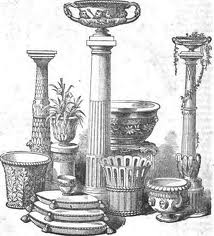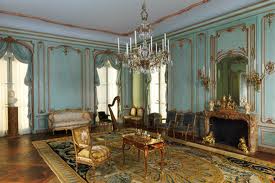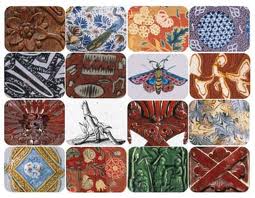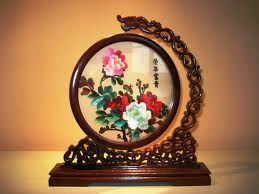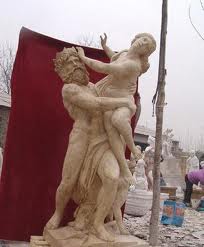Crafts – Metal Work
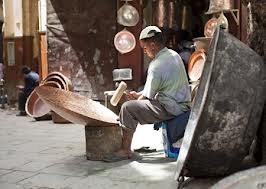
[ Source Info:
http://en.wikisource.org/wiki/Arts_and_Crafts_Essays/Metal_Work ]
METAL WORK
By W. A. S. Benson
In discussing the artistic aspect of metal work, we have to take into account the physical properties and appropriate treatment of the following metals: the precious metals, gold and silver; copper, both pure and alloyed with other metals, especially tin and zinc in various proportions to form the many kinds of brass and bronze; lead, with a group of alloys of which pewter is typical; and iron, in the three forms of cast iron, wrought iron, and steel. All these have been made to serve the purpose of the artist, and the manipulation of them, while presenting many differences in detail, presents certain broad characteristics in common which distinguish them from the raw material of other crafts. Whether they are found native in the metallic state as is usual in the case of gold, or combined with many other minerals in the form of ore as is more common with other metals, fire is the primal agency by which they are made available for our needs. The first stage in their manipulation is to melt and cast them into ingots of a size convenient to the purpose intended. Secondly, all these metals when pure, and many alloys, are in varying degree malleable and ductile, are, in fact, if sufficient force be applied, plastic. Hence arises the first broad division in the treatment of metals. The fluid metal may, by the use of suitable moulds, be cast at once to the shape required, or the casting may be treated merely as the starting-point for a whole series of operations — forging, rolling, chipping, chasing, wire-drawing, and many more. Another property of the metals which must be noticed is, that not only can separate masses of metals be melted down and fused into one, but it is possible, under various conditions, of which the one invariably necessary is perfectly clean surfaces of contact, to unite separate portions of the same or different metals without fusion of the mass. For our present purpose the most important instance of this is the process of soldering, by which two surfaces are united by the application of sufficient heat to melt more fusible metal which is introduced between them, and which combines with both so as firmly to unite them on solidifying. Closely allied to this are the processes by which one metal is, for purposes of adornment or preservation from corrosion, coated with a thin film or deposit of another, usually more costly, metal.
Though hereafter electro-metallurgy may assert its claim to artistic originality as a third division, for the present all metal work, so far as its artistic aspect depends upon process, falls naturally into one of the two broad divisions of cast metal and wrought metal. Both have been employed from a time long anterior to written history; ornaments of beaten gold, and tools of cast bronze, are alike found among the relics of very early stages of civilisation, and in early stages both alike are artistic. The choice between the two processes is determined by such considerations as convenience of manufacture and the physical properties of the metals, and the different purposes in view. When a thick and comparatively massive shape is required, it is often easier to cast it at once. For thinner and lighter forms it is usually more convenient to treat the ingot or crude product of the furnace as mere raw material for a long series of workings under the hammer, or its patent mechanical equivalents, the rolling and pressing mills of modern mechanics. The choice is further influenced by the toughness generally characteristic of wrought metal, whereas the alloys which yield the cleanest castings are by no means universally the best in other respects. Iron is the extreme instance of this: ordinary cast iron being an impure form of the metal, which is too brittle to be worked under the hammer, but is readily cast into moulds, being fluid at a temperature which, though high, is easily obtained in a blast furnace. Wrought iron, however, which is usually obtained from cast iron by a process called puddling, whereby the impurities are burnt out, does not become fluid enough to pour into moulds; but on the other hand, pieces at a white heat can be united into a solid mass by skilful hammering, a process which is called welding, and, together with the fact that from its great hardness it is usually worked hot, is specially distinctive of the blacksmith’s craft. In no other metal is the separation between the two branches so wide as in iron. The misdirected skill of some modern iron-founders has caused the name of cast iron to be regarded as the very negative of art, and has even thrown suspicion on the process of casting itself as one of questionable honesty. Nevertheless, as a craft capable of giving final shape to metal, it has manifestly an artistic aspect, and, in fact, bronze statuary, a fine art pure and simple, is reproduced from the clay model merely by moulding and casting. We must therefore look for the artistic conditions in the preparation of the model or pattern, the impress of which in sand or loam forms the mould; the pattern may be carved in wood or modelled in clay, but the handling of the wood or clay is modified by the conditions under which the form is reproduced. And lastly, the finished object may either retain the surface formed as the metal solidifies, as in the case of the bronzes cast by the wax process, or the skin may be removed by the use of cutting tools, chisels and files and gravers, so that, as in the case of many of the better French bronzes, the finished work is strictly carved work. On the contrary, much silversmith’s work, as well as such simple objects as Chinese gongs and Indian “lotahs,” after being cast approximately to shape are finished by hammer work, that is, treated as plastic material with tools that force the material into shape instead of cutting the shape out of the mass by removing exterior portions of material. Attempts to imitate both processes by casting only, thus dispensing with the cost of finishing, are common, but as they dispense likewise with all beauty in the product, even if they do not substitute varnished and tinted zinc for better metal, their success is commercial only.
We have thus three characteristic kinds of surface resulting from the conditions of treatment, marking out three natural divisions of the art: and be it noted that questions of surface or texture are all-important in the arts; beauty is skin deep. First, the natural skin of the metal solidified in contact with the mould, and more or less closely imitative of the surface of the original model, usually for our purposes a plastic surface; secondly, there is carved, technically called chased, work; and thirdly, beaten or wrought work, which in ornament is termed embossing.
Superimposed on these we have the cross divisions of the crafts according to the special metal operated on, and in the existing industrial organisation the groups thus obtained have to be further divided into many sub-heads, according to the articles produced; and finally, another commercial distinction has to be drawn which greatly affects the present condition of handicraft, that is, the division of the several trades into craftsmen and salesmen. There can be no doubt that the extent of the existing dissociation of the producing craftsman from the consumer is an evil for the arts, and that the growing preponderance of great stores is inimical to excellence of workmanship. It is, perhaps, an advantage for the workman to be relieved from the office of salesman; the position of the village smith plying his calling in face of his customers might not suit every craft, but the services of the middleman are dearly bought at the price of artistic freedom. It is too often in the power of the middleman to dictate the quality of workmanship, too often his seeming interest to ordain that it shall be bad.
The choice of a metal for any particular purpose is determined by physical properties combined with considerations of cost. Iron, if only for its cheapness, is the material for the largest works of metal; while in the form of steel it is the best available material for many very small works, watch-springs for instance:it has the defect of liability to rust; the surfaces of other metals may tarnish, but iron rusts through. For the present only one application of cast iron concerns us — its use for grates and stoves. The point to remember is, that as the material has but little beauty, its employment should be restricted to the quantity prescribed by the demands of utility. Wrought iron, on the contrary, gives very great scope to the artist, and it offers this peculiar advantage, that the necessity of striking while the iron is hot enforces such free dexterity of handling in the ordinary smith, that he has comparatively little to learn if set to produce ornamental work, and thus renewed interest in the art has found craftsmen enough who could readily respond to the demand made upon them.
Copper, distinguished among metals by its glowing red tint, has as a material for artistic work been overshadowed by its alloys, brass and bronze; partly because they make sounder castings, partly it is to be feared from the approach of their colour to gold. Holding an intermediate position between iron and the precious metals, they are the material of innumerable household utensils and smaller architectural fittings.
Lead, tin, and zinc scarcely concern the artist to-day, though neither plumber nor pewterer has always been restricted to plain utilitarianism. Gold and silver have been distinguished in all ages as the precious metals, both for their comparative rarity and their freedom from corrosion, and their extreme beauty. They are both extremely malleable and very readily worked. Unhappily there is little original English work being done in these metals. The more ordinary wares have all life and feeling taken out of them by mechanical finish, an abrasive process being employed to remove every sign of tool-marks. The all-important surface is thus obliterated. As to design, fashion oscillates between copies of one past period and another. A comparison of one of these copies with an original will make the distinction between the work of a man paid to do his quickest and one paid to do his best clearer than volumes of description. Indeed, when all is said, a writer can but indicate the logic that underlies the craft, or hint at the relation which subsists between the process, the material, and the finished ware: the distinction between good and bad in art eludes definition; it is not an affair of reason, but of perception.
©W. A. S. BENSON
[for the article Full Rights Reserved ©Wikisource Website, W. A. S. Benson]
